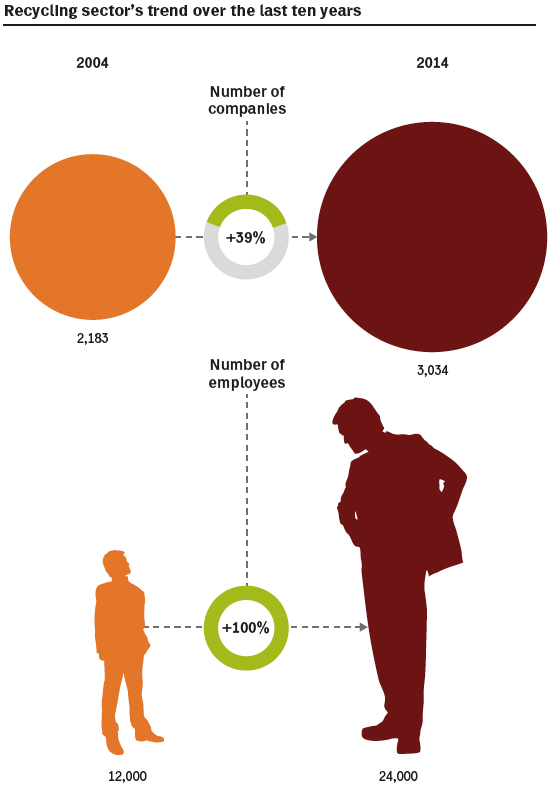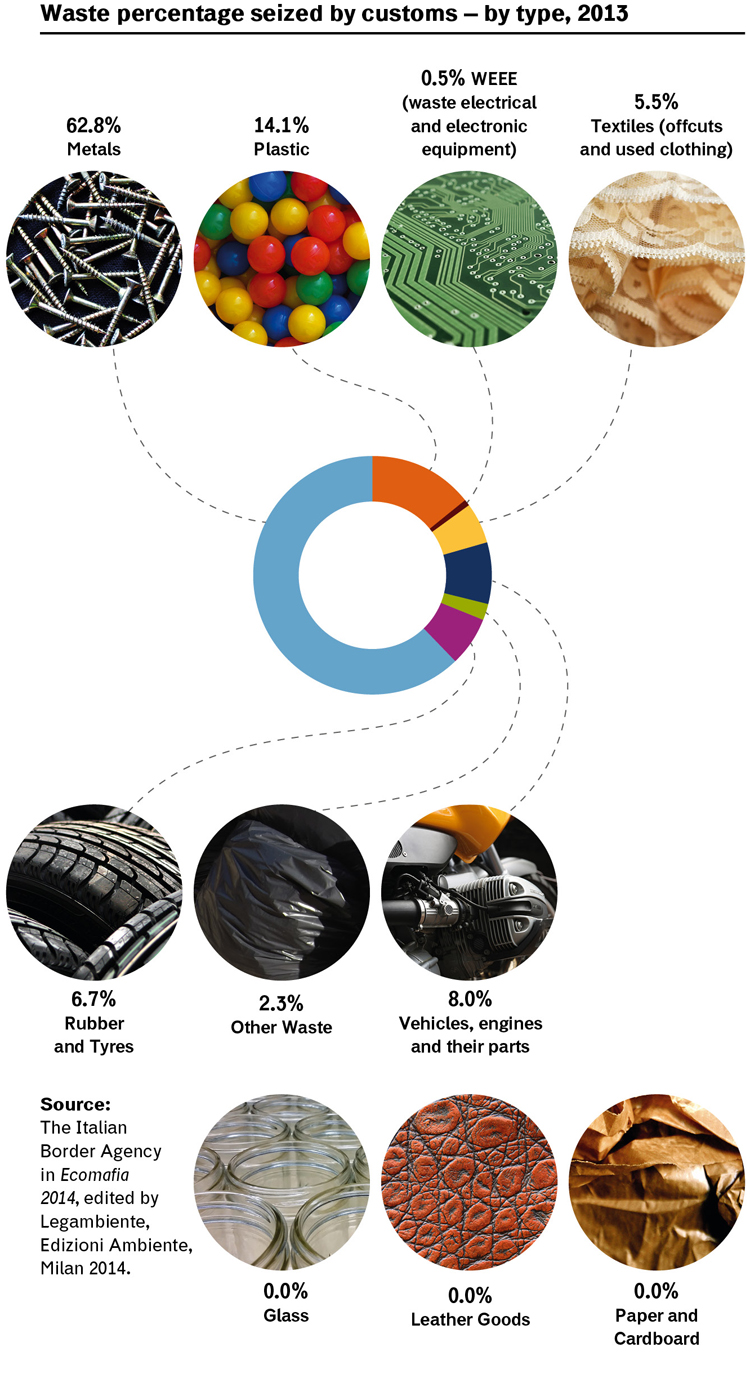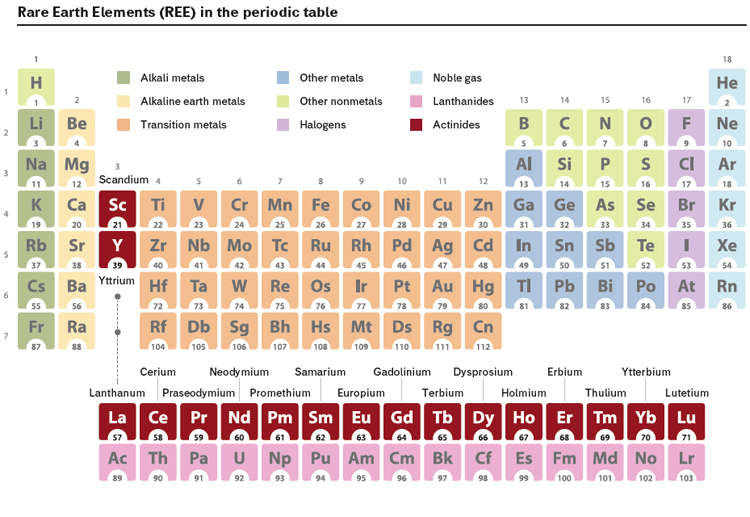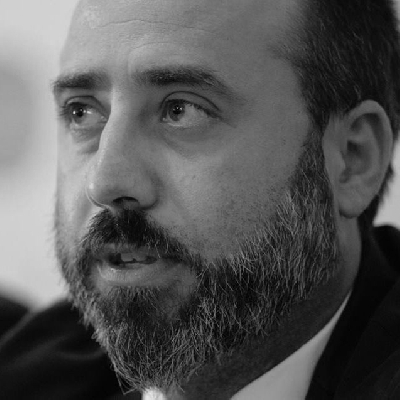
So, a substantial overall growth bolstered by many industries. In 2010, building sites recycled and used 51 million tons of inert waste and 22 million of scrap iron (equalling 77% of the iron and steel total national production). The Italian metallurgical sector relies on scrap metal. In 2011 Italy became the first EU country for the quantity of aluminium obtained from secondary raw materials, recycling as much as 927,000 tons. The lead industry depends on scrap (92% from used batteries), in 2010 as many as 165,000 tons were recovered. After the metallurgical sector, the paper one is the second relying the most on waste: in the same year, over 5 million tons of pulp paper were fed back into the production cycle, making up nearly 59% of the national output.
Italy also ranks second in the EU for the amount of plastic waste recovered, about 1.7 million tons thanks to 200 polymer recycling companies treating over 400,000 tons of low density polyethylene and 300,000 tons of low and medium density one, over 350,000 tons of polypropylene, 200,000 of PET and 100,000 of PVC. The glass industry too depends on recovery: of the 5.2 million tons produced in 2011, more than 2 million came from recycling. Nevertheless, Italy is still a secondary raw materials net importer. Against 7.1 million tons of imported materials, it exported 2.8 million: a negative balance of 4.3 million tons of materials, worth €2.2 billion. Therefore, despite the high recycling levels, there is still room for further growth.
Such trend is confirmed by global data. Over the last ten years, international trade for iron and aluminium scrap and paper, plastic and wood waste has virtually doubled. As for scrap iron, it went from 61 million tons in 2000 to almost 108 in 2011 (an increase of 75%), while plastic waste soared by 260% (from 4.5 million tons of 2000 to 14.84 million of 2011). Monetarily, the overall trade of these five materials is worth more or less US$90 billion yearly.
According to the Border Agency, in 2013 alone, the EU exported nearly 17 million tons of scrap metal, nearly 10 million tons of cardboard and paper, nearly 3 million tons of plastic and 329,000 tons of rubber. Within the EU, Germany is the top exporter of plastic – about 1 million tons (33% of the EU total trade) – while the UK is the biggest exporter of scrap metal – more than 4.7 million tons (28% of the EU’s total) – and of recycled paper and cardboard, about 3 million and 700,000 respectively (37%). France’s major export is rubber waste, nearly 82.000 tons per year (25%).
Since these are strategic resources for the European manufacturing sector, in 2011 the European Economic and Social Committee (EESC) stated that it even considered introducing “export duties to protect the EU from the risk of losing very useful materials”. In particular, claiming that “the EU should negotiate emergency solutions with the WTO, setting clear and transparent limitations or duties on strategically important waste materials”.
Waste Grabbing
Today, waste is the new urban mine to plunder. For each material, there is a stock exchange with price quotations. In the case of recycled polyethylene-based materials, blue PET chips can cost up to €1,000 per ton. Recycled aluminium from cans and scrap copper fetch €1,500, discarded tyres €500, textile waste €280, scrap iron €168 (€400 if steel), vegetable oils €250, WEEE €300, medical waste €470 and so on. Much better than burying them in an olive grove!
Therefore, the “new dealer” trades in materials with high economic and strategic value. This is particularly true in Italy, a country that boasts a long recycling tradition and one of the worst affected by the illegal drain of these materials towards foreign countries. As Duccio Bianchi notes, in 2010, while in Europe the industrial recovery of recyclables (metals, paper, plastic, glass, wood, textiles and rubber) amounted to 163 million tons, Italy recovered 24.1 million tons, the highest amount in Europe, ahead of Germany’s 22.4 million tons. In particular, Italy is the European leader in recycling ferrous metals, plastic and textiles. After the US and Japan, Italy is the third biggest recycler of aluminium worldwide. Stopping the illegal trafficking means defending part of the green economy. So, instead of carrying on hunting the old local traffickers, we must now face up to this new breed: actual businessmen, brokers on the international market of raw materials, paying attention to stock market quotes, to the value of these materials and to individual country’s hunger for raw materials. Traffickers who run real mobs, in some cases Mafia-style organizations. Informal, flexible, non-territorial, situational criminal networks that differ from actual criminal enterprises because they are not necessarily characterized by structured organizations, shared values and established operating borders and hierarchy. Shifty Chinese shadows able to elude even the most expert investigators.
These criminal networks fully understand that such materials are fundamental, especially for countries with well-established manufacturing industries, and scarce resources and advanced recycling systems such as Italy and Germany. Or countries with double-digit growth rates such as the BRIC – Brazil, Russia, India and China. All this triggers waste grabbing to satisfy raw materials hunger of old and new economic players; such demand is further accentuated by new sustainability policies incentivizing collection and recycling, especially in the EU.
Recyclers struggling for the scarcity of supplies wonder where these materials have gone. The Border Agency is proving an answer though seizures at borders. In 2013, Italian Port Authorities checked 4,359 tons of waste, 69% was metals, over 14% plastic and then tyres, textiles, scrapped vehicles and WEEE. Desert Waste is the name of one of the most recent investigations on this front carried out last May. Investigators seized four semi-trailers bound for Iran and Libya containing ferrous waste, pieces of scrapped lorries, exhausted batteries, tyres and WEEE amounting to about 70 tons.
Eurostat data confirm that waste has already conquered the raw material market, following the footsteps of production delocalization and trade globalization. Between 2001 and 2009, legal exports of waste from EU countries to non-EU countries rose by 131%. Between 1999 and 2011, plastic exports amongst EU countries grew fivefold, from about 1 million tons to over 5 million. Metal waste exports followed a similar trend, over the same period they more than tripled. At the same time, illegal routes also grew as shown by the data of seizures carried out by Customs in Italian ports over the last two years: nearly 20,000 tons of waste (18,800 to be precise) bound for illegal export, above all plastic, paper and cardboard, scrap iron, end-of-life tyres (ELTs) and waste electrical and electronic equipment (WEEE). An increase of about 35% compared to the 2008-2009 period when border seizures amounted to just over 12,000 tons. In 2012 alone, 59% of ELTs, 16.5% of scrap metal and over 14% of plastic waste exports were illegal and therefore seized by the Italian Border Agency.

WEEE and Rare Earth Elements (REE)
Traffickers’ most popular waste materials are WEEE, a treasure trove of materials and Rare Earth Elements (REE), 17 chemical elements of the periodic table used in hi-tech products (PC, monitors, mobile phones, etc.). To understand their value, one just needs to analyse the REE price chart. According to ENEA, their price has enjoyed a stable and constant growth rate from 2003 to date (despite a setback in 2013) following the strong demand for hi-tech products. Today, the demand of neodymium, praseodymium and dysprosium for the production of magnets keeps driving the market. In the future, the use of europium, terbium and yttrium for the production of phosphates could further increase their market value.

In 2012, the worldwide mining production of these rare earth elements – with a demand that could overtake supply in the very near future – was estimated at 110,000 tons by the USGS (U.S. Geological Survey). China is the leading producer, it generates 97% of the demand and holds 55% of the reserves. A true monopoly.
Italy does not yet have plants able to recover REEs from WEEEs. It thus loses an incredible resource that, as it can be imagined, traffickers and informal channels are ready to tap into: in Italy alone, waste dealers manage 900,000 tons of WEEs per year. Recently, one of the leading Italian association in this sector, Ecodom, has railed against their swindle, arguing that over 65% of this waste ends up in the illegal trade, bound for China and some African countries. According to General Director Giorgio Arienti’s analysis, trafficking trends reflect secondary raw materials prices: when they rise, illegal trafficking also expands and vice versa.
The same applies to the rest of Europe. There is no production of REES, recycling amounts to a symbolic 1% while producing electrical and electronic equipment that ends up as WEE. It is no surprise then that over the last 5 years, the EU has been a net importer of REE, metals and alloys for about 12,000 tons per year.
Stopping illegal flows of these waste materials has become an ever more urgent question in order to prevent incalculable damage to the legal economy and the environment. The response must not be limited to repression because it is of very little use without innovating both processes and products. The best way to tackle ecomafias and environmental crime is to adopt brand new economic models envisaging a circular, shared and sustainable approach rather than the old linear one. As many years of studying rubbish traffickers’ routes have taught us, the best way to check their power is to change the market, starving their alibis and playing field of oxygen and blacking them out from history.


